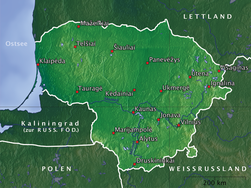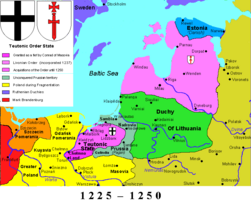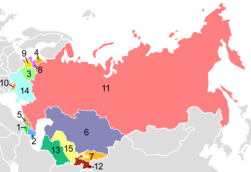Atlas of Lithuania

|
Wikimedia Commons Atlas of the World The Wikimedia Atlas of the World is an organized and commented collection of geographical, political and historical maps available at Wikimedia Commons. Discussion • Update the atlas • Index of the Atlas • Atlas in categories • Other atlases on line |
|
| ||||||||||||||||||||||||||||||||||||||||||||
In Lithuanian
General maps

|
Map of Lithuania |

|
Map of Lithuania (German)[1] |

|
High resolution map of Lithuania (blank or German language available)[2][3][4] |

|

|

|
Physical map of Lithuania |

|
Physical map |

|
Physical map |
Maps of divisions
This section holds maps of the administrative divisions.

|
Counties of Lithuania |

|
Counties and municipalities of Lithuania |

|
Elderships of Lithuania |
-
Alytus County
-
Utena County
-
Šiauliai County
-
Panevėžys County
-
Telšiai County
-
Tauragė County
-
Klaipėda County
-
Marijampolė County
-
Kaunas County
-
Vilnius County
-
Akmenė District Municipality
-
Elderships of Akmenė District Municipality
-
Alytus City Municipality
-
Alytus District Municipality
-
Elderships of Alytus District Municipality
-
Anykščiai District Municipality
-
Elderships of Anykščiai District Municipality
-
Birštonas Municipality
-
Elderships of Birštonas Municipality
-
Biržai District Muncipality
-
Elderships of Biržai District Municipality
-
Druskininkai Municipality
-
Elderships of Druskininkai Municipality
-
Elektrėnai Municipality
-
Elderships of Elektrėnai Municipality
-
Ignalina District Municipality
-
Elderships of Ignalina District Municipality
-
Jonava District Municipality
-
Elderships of Jonava District Municipality
-
Joniškis District Municipality
-
Elderships of Joniškis District Municipality
-
Jurbarkas District Municipality
-
Elderships of Jurbarkas District Municipality
-
Kaišiadorys District Municipality
-
Elderships of Kaišiadorys District Municipality
-
Kalvarija Municipality
-
Elderships of Kalvarija Municipality
-
Kaunas City Municipality
-
Aleksotas and other elderships of Kaunas City Municipality
-
Kaunas District Municipality
-
Elderships of Kaunas District Municipality
-
Kazlų Rūda Municipality
-
Elderships of Kazlų Rūda Municipality
-
Kėdainiai District Municipality
-
Elderships of Kėdainiai District Municipality
-
Kelmė District Municipality
-
Elderships of Kelmė District Municipality
-
Klaipėda City Municipality
-
Klaipėda District Municipality
-
Elderships of Klaipėda District Municipality
-
Kretinga District Municipality
-
Elderships of Kretinga District Municipality
-
Kupiškis District Municipality
-
Elderships of Kupiškis District Municipality
-
Lazdijai District Municipality
-
Elderships of Lazdijai District Municipality
-
Marijampolė Municipality
-
Elderships of Marijampolė District Municipality
-
Mažeikiai District Municipality
-
Elderships of Mažeikiai District Municipality
-
Molėtai District Municipality
-
Elderships of Molėtai District Municipality
-
Neringa Municipality
-
Pagėgiai Municipality
-
Elderships of Pagėgiai Municipality
-
Pakruojis District Municipality
-
Elderships of Pakruojis District Municipality
-
Palanga City Municipality
-
Panevėžys City Municipality
-
Panevėžys District Municipality
-
Elderships of Panevėžys District Municipality
-
Pasvalys District Municipality
-
Elderships of Pasvalys District Municipality
-
Plungė District Municipality
-
Elderships of Plungė District Municipality
-
Prienai District Municipality
-
Elderships of Prienai District Municipality
-
Radviliškis District Municipality
-
Elderships of Radviliškis District Muncipality
-
Raseiniai District Municipality
-
Elderships of Raseiniai District Municipality
-
Rietavas Municipality
-
Elderships of Rietavas Municipality
-
Rokiškis District Municipality
-
Elderships of Rokiškis District Municipality
-
Skuodas District Municipality
-
Elderships of Skuodas District Municipality
-
Šakiai District Municipality
-
Elderships of Šakiai District Municipality
-
Šalčininkai District Municipality
-
Elderships of Šalčininkai District Municipality
-
Šiauliai City Municipality
-
Šiauliai District Municipality
-
Elderships of Šiauliai District Municipality
-
Šilalė District Municipality
-
Elderships of Šilalė District Municipality
-
Šilutė District Municipality
-
Elderships of Šilutė District Municipality
-
Širvintos District Municipality
-
Elderships of Širvintos District Municipality
-
Švenčionys District Municipality
-
Elderships of Švenčionys District Municipality
-
Tauragė District Municipality
-
Elderships of Tauragė District Municipality
-
Telšiai District Municipality
-
Elderships of Telšiai District Municipality
-
Trakai District Municipality
-
Elderships of Trakai District Municipality
-
Ukmergė District Municipality
-
Elderships of Ukmergė District Municipality
-
Utena District Municipality
-
Elderships of Utena District Municipality
-
Varėna District Municipality
-
Elderships of Varėna District Municipality
-
Vilkaviškis District Municipality
-
Elderships of Vilkaviškis District Municipality
-
Vilnius City Municipality
-
Elderships of Vilnius City Municipality
-
Vilnius District Municipality
-
Elderships of Vilnius District Municipality
-
Visaginas Municipality
-
Zarasai District Municipality
-
Elderships of Visaginas District Municipality
History maps
This section holds a short summary of the history of the area of present-day Lithuania, illustrated with maps, including historical maps of former countries and empires that included present-day Lithuania.
Early history

|
Map of the distribution of hydronymes of Baltic origin. The main area is dark blue, the peripheral area is light blue. |

|
Balts during IV-III centuries B.C. |

|
Baltic Tribes around 1200 |

|
The Monastic state of the Teutonic Knights 1225-1250 |
Independent Lithuania

|
Historical map of Lithuania at 1240-1263 |

|
Historical map of Lithuania at 1316-1341 |

|
Historical map of Lithuania at 1345-1377 |

|
Lithuania in the 13th and 15th century |

|
The Monastic state of the Teutonic Knights 1308–1455 |

|
The Monastic state of the Teutonic Knights 1466 |

|
In 1386 Poland and Lithuania formed a Polish-Lithuanian personal union, succeeded in 1569 by the Polish-Lithuanian Commonwealth. Large parts of present-day Belarus and Ukraine were part of Poland-Lithuania. This map shows the borders in 1466 |

|
Lithuania and Poland in 1387 |

|
Administrative divisions of Lithuania in 1430 |

|
Lithuanian language areas in the 16th century |
Polish Lithuanian Commonwealth

|
1569-1795: Polish-Lithuanian Commonwealth - Independent country, including present-day Lithuania ► Poland In 1569 the personal union is succeeded by the Polish-Lithuanian Commonwealth, a state that existed until the 3rd partition of 1795. |

|
Map of the Commonwealth in 1569 |

|
Grand Duchy of Lithuania in 1613 |
Incorporation into the Russian Empire

|
The third partition meant the end of the Polish-Lithuanian Commonwealth and the final division between Prussia, Russia and Austria after 3rd partition |

|
Lithuania's administrative divisions in the 17th century |

|
Lithuania after 3rd partitions (1795) |

|
Russian Empire |

|
The Russian Empire in 1866 |

|
History of the Russian Empire (in German) |

|
Ethnographic map of Lithuanians and Latvians in 1847 |

|
Ethnic map of the former Polish-Lithuanian Commonwealth in 1863 |

|
Ethnological map of Lithuania and Belarus |

|
Lithuania in the Russian Empire (1867-1914) |

|
The map of the Lithuanian - Latvian land, 1900 |

|
Russia in 1912 |
Independent Lithuania in the interbellum

|
Lithuanian claims in Poland in 1920 |

|
Republic of ► Central Lithuania. |

|
Lithuania claims and the Republic of Central Lithuania |

|
Changing border between Lithuania and Poland. In 1923 Lithuania occupies and annexes the ► Memel Territory in the "Klaipeda Revolt". The Memel Territory was a former ► German territory under protection of the League of Nations since 1920. |

|
Map of Lithuania (Carte de Lithuanie), with the territory occupied by Poland in the 1930s |
Soviet annexation

|
Lithuania is annexed by the Soviet Union in 1940. Location of the USSR |

|
Evolution of the Soviet Union |

|
The republics of the USSR |

|
Soviet Lithuania |

|
Map of the 1949 geographic location of various ethnic groups within the Soviet Union |

|
Soviet Union administrative divisions, 1989 |
Restored independence
History of other entities
Central Lithuania
| 1920-1922: Republic of Central Lithuania (Vidurio Lietuvos Respublika, Republika Litwy Środkowej, Рэспубліка Сярэдняе Літвы - Respublika Siaredniaje Litvy) - |

|
Republic of Central Lithuania |

|
Lithuania claims and the Republic of Central Lithuania |
Klaipėda
| 1920-1923: Memel Territory (Memelgebiet, Klaipėdos kraštas) - territory under protection of the League of Nations |

|
Memel Territory annexed by Germany |
Other maps

|
Population density |

|
Ethnographic map |

|
Litauische Ostseeküste |

|
Lithuania-Latvia interconnection |
Satellite maps

|
Satellite map |
Notes and references
|
General remarks:
|































































































































